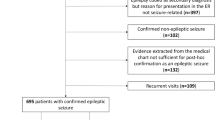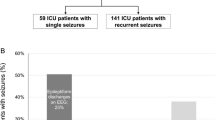Abstract
Purpose of Review
This review seeks to inform ED providers about best practices in the evaluation and treatment of new onset seizures in adults as well as those with established seizure diagnosis and breakthrough seizures.
Recent Findings
Current evidence suggests that early EEG has a higher rate of detecting epileptiform activity which is important as it can determine which patients need initiation of AED therapy. Early initiation of AEDs is important because although it does not have a mortality benefit or improve long-term remission it does improve quality of life and number of seizures.
Summary
Appropriate assessment and treatment of new onset and breakthrough seizures are crucial for this common presentation. Successfully ruling out other etiologies and ensuring timely follow-up and EEG/neuroimaging are key decisions ED providers must make in the care of these patients. Given the variability of neurology consultation and follow-up based on location, ED providers must understand and well utilize their available resources to advocate for best care for patients with seizures in their EDs.

Similar content being viewed by others
References
Paper of particular interest, published recently, have been highlighted as: • Of importance
Gavvala JR, Schuele SU. New-onset seizure in adults and adolescents: a review. JAMA. 2016;316(24):2657–68.
Russ SA, Larson K, Halfon N. A national profile of childhood epilepsy and seizure disorder. Pediatrics. 2012;129(2):256–64.
Bank AM, Bazil CW. Emergency management of epilepsy and seizures. Semin Neurol. 2019;39(1):73–81.
Huff JS, Morris DL, Kothari RU, Gibbs MA, Emergency Medicine Seizure Study G. Emergency department management of patients with seizures: a multicenter study. Acad Emerg Med. 2001;8(6):622–8.
Sartori S, Nosadini M, Tessarin G, Boniver C, Frigo AC, Toldo I, et al. First-ever convulsive seizures in children presenting to the emergency department: risk factors for seizure recurrence and diagnosis of epilepsy. Dev Med Child Neurol. 2019;61(1):82–90.
Montouris GD, Jagoda AS. Management of breakthrough seizures in the emergency department: continuity of patient care. Curr Med Res Opin. 2007;23(7):1583–92.
Zack MM, Kobau R. National and state estimates of the numbers of adults and children with active epilepsy — United States, 2015. MMWR Morb Mortal Wkly Rep. 2017;66(31):821–5.
Bergey GK. Management of a first seizure. Continuum (Minneap Minn). 2016;22(1 Epilepsy):38–50.
Fisher RS, Acevedo C, Arzimanoglou A, Bogacz A, Cross JH, Elger CE, et al. ILAE official report: a practical clinical definition of epilepsy. Epilepsia. 2014;55(4):475–82.
Beghi E, Carpio A, Forsgren L, Hesdorffer DC, Malmgren K, Sander JW, et al. Recommendation for a definition of acute symptomatic seizure. Epilepsia. 2010;51(4):671–5.
Bonnett LJ, Powell GA, Tudur Smith C, Marson AG. Breakthrough seizures—further analysis of the Standard versus New Antiepileptic Drugs (SANAD) study. PLoS ONE. 2017;12(12): e0190035.
Kazl C, LaJoie J. Emergency seizure management. Curr Probl Pediatr Adolesc Health Care. 2020;50(11): 100892.
Nowacki TA, Jirsch JD. Evaluation of the first seizure patient: key points in the history and physical examination. Seizure. 2017;49:54–63.
Pottkamper JCM, Hofmeijer J, van Waarde JA, van Putten M. The postictal state — what do we know? Epilepsia. 2020;61(6):1045–61.
Brigo F, Nardone R, Ausserer H, Storti M, Tezzon F, Manganotti P, et al. The diagnostic value of urinary incontinence in the differential diagnosis of seizures. Seizure. 2013;22(2):85–90.
Alessi N, Perucca P, McIntosh AM. Missed, mistaken, stalled: identifying components of delay to diagnosis in epilepsy. Epilepsia. 2021;62(7):1494–504.
Hauser WA, Annegers JF, Kurland LT. Incidence of epilepsy and unprovoked seizures in Rochester, Minnesota: 1935–1984. Epilepsia. 1993;34(3):453–68.
Jagoda A, Gupta K. The emergency department evaluation of the adult patient who presents with a first-time seizure. Emerg Med Clin North Am. 2011;29(1):41–9.
Reinecke LCS, Doerrfuss JI, Kowski AB, Holtkamp M. Acute symptomatic seizures in the emergency room: predictors and characteristics. J Neurol. 2022;269(5):2707–14.
Leung H, Man CB, Hui AC, Kwan P, Wong KS. Prognosticating acute symptomatic seizures using two different seizure outcomes. Epilepsia. 2010;51(8):1570–9.
Matz O, Heckelmann J, Zechbauer S, Litmathe J, Brokmann JC, Willmes K, et al. Early postictal serum lactate concentrations are superior to serum creatine kinase concentrations in distinguishing generalized tonic-clonic seizures from syncopes. Intern Emerg Med. 2018;13(5):749–55.
Kishk NA, Sharaf Y, Ebraheim AM, Baghdady Y, Alieldin N, Afify A, et al. Interictal cardiac repolarization abnormalities in people with epilepsy. Epilepsy Behav. 2018;79:106–11.
Jimenez-Villegas MJ, Lozano-Garcia L, Carrizosa-Moog J. Update on first unprovoked seizure in children and adults: a narrative review. Seizure. 2021;90:28–33.
Harden CL, Huff JS, Schwartz TH, Dubinsky RM, Zimmerman RD, Weinstein S, et al. Reassessment: neuroimaging in the emergency patient presenting with seizure (an evidence-based review): report of the Therapeutics and Technology Assessment Subcommittee of the American Academy of Neurology. Neurology. 2007;69(18):1772–80.
• Salinsky M, Wong VSS, Motika P, Meuse J, Nguyen J. Emergency department neuroimaging for epileptic seizures. Epilepsia. 2018;59(9):1676–83. Emergency department neuroimaging for epileptic seizures: retrospective analysis of 822 ED visits for recurrent seizures in epileptics at the Oregon Health & Science University and the VA Portland Health Care System. Results indicated that more conservative ED neuroimaging for recurrent seizures, based on clinical factors at presentation, could be decrease imaging frequency with a minimal loss of yield.
Kalilani L, Faught E, Kim H, Burudpakdee C, Seetasith A, Laranjo S, et al. Assessment and effect of a gap between new-onset epilepsy diagnosis and treatment in the US. Neurology. 2019;92(19):e2197–208.
Krumholz A, Shinnar S, French J, Gronseth G, Wiebe S. Evidence-based guideline: management of an unprovoked first seizure in adults: report of the Guideline Development Subcommittee of the American Academy of Neurology and the American Epilepsy Society. Neurology. 2015;85(17):1526–7.
• Leone MA, Giussani G, Nevitt SJ, Marson AG, Beghi E. Immediate antiepileptic drug treatment, versus placebo, deferred, or no treatment for first unprovoked seizure. Cochrane Database Syst Rev. 2021;5:CD007144. Cochrane review looking at immediate antiepileptic drug treatment versus placebo, deferred or no treatment for first unprovoked seizure: reinforces the concept that early treatment with AEDs will reduce the risk of recurrence significantly in the first five years, however indicates no mortality benefit at 20 years and increased risk of adverse events with medication. Strong overall review of current literature on AED use for new seizures.
Yigit O, Eray O, Mihci E, Yilmaz D, Arslan S, Eray B. The utility of EEG in the emergency department. Emerg Med J. 2012;29(4):301–5.
Krumholz A, Wiebe S, Gronseth G, Shinnar S, Levisohn P, Ting T, et al. Practice parameter: evaluating an apparent unprovoked first seizure in adults (an evidence-based review): report of the Quality Standards Subcommittee of the American Academy of Neurology and the American Epilepsy Society. Neurology. 2007;69(21):1996–2007.
Wyman AJ, Mayes BN, Hernandez-Nino J, Rozario N, Beverly SK, Asimos AW. The first-time seizure emergency department electroencephalogram study. Ann Emerg Med. 2017;69(2):184–91 e1.
Sofat P, Teter B, Kavak KS, Gupta R, Li P. Time interval providing highest yield for initial EEG in patients with new onset seizures. Epilepsy Res. 2016;127:229–32.
Smith SJ. EEG in the diagnosis, classification, and management of patients with epilepsy. J Neurol Neurosurg Psychiatry. 2005;76(Suppl 2):ii2–7.
King MA, Newton MR, Jackson GD, Fitt GJ, Mitchell LA, Silvapulle MJ, et al. Epileptology of the first-seizure presentation: a clinical, electroencephalographic, and magnetic resonance imaging study of 300 consecutive patients. Lancet. 1998;352(9133):1007–11.
Krumholz A, Wiebe S, Gronseth GS, Gloss DS, Sanchez AM, Kabir AA, et al. Evidence-based guideline: management of an unprovoked first seizure in adults: report of the Guideline Development Subcommittee of the American Academy of Neurology and the American Epilepsy Society. Neurology. 2015;84(16):1705–13.
• Bao EL, Chao LY, Ni P, Moura L, Cole AJ, Cash SS, et al. Antiepileptic drug treatment after an unprovoked first seizure: a decision analysis. Neurology. 2018;91(15):e1429-e39. Antiepileptic drug treatment after an unprovoked seizure: takes into account Quality of Life and monetary value for the AED initation treatment algorithm and shows that early treatment of an unprovoked seizure in a patient with low comorbidities benefits greatly from having their recurrence rate lowered in the short term, as opposed to delayed treatments. Also indicates that the ILAE recommended epilepsy definition of >60% risk of recurrence in 10 years for initiation of AEDs is likely too high and that they recommend a more conservative 38%.
Perucca P, Scheffer IE. Genetic contributions to acquired epilepsies. Epilepsy Curr. 2021;21(1):5–13.
Bonnett LJ, Powell GA, Tudur Smith C, Marson AG. Risk of a seizure recurrence after a breakthrough seizure and the implications for driving: further analysis of the standard versus new antiepileptic drugs (SANAD) randomised controlled trial. BMJ Open. 2017;7(7):e015868.
Ettinger AB, Manjunath R, Candrilli SD, Davis KL. Prevalence and cost of nonadherence to antiepileptic drugs in elderly patients with epilepsy. Epilepsy Behav. 2009;14(2):324–9.
Samsonsen C, Reimers A, Brathen G, Helde G, Brodtkorb E. Nonadherence to treatment causing acute hospitalizations in people with epilepsy: an observational, prospective study. Epilepsia. 2014;55(11):e125–8.
Kvam KA, Douglas VC, Whetstone WD, Josephson SA, Betjemann JP. Yield of emergent CT in patients with epilepsy presenting with a seizure. Neurohospitalist. 2019;9(2):71–8.
Author information
Authors and Affiliations
Corresponding author
Ethics declarations
Conflict of Interest
Ross Taylor, Arion Lochner, Taher Vohra, Daniel Grahf, Reba John, and Seth Krupp declare that they have no conflict of interest.
Human and Animal Rights and Informed Consent
This article does not contain any studies with human or animal subjects performed by any of the authors.
Additional information
Publisher's Note
Springer Nature remains neutral with regard to jurisdictional claims in published maps and institutional affiliations.
This article is part of the Topical Collection on Neurologic Emergencies
Rights and permissions
Springer Nature or its licensor holds exclusive rights to this article under a publishing agreement with the author(s) or other rightsholder(s); author self-archiving of the accepted manuscript version of this article is solely governed by the terms of such publishing agreement and applicable law.
About this article
Cite this article
Taylor, R., Lochner, A., Grahf, D. et al. Evaluation and Management of New Onset and Breakthrough Seizures in Adults in the Emergency Department. Curr Emerg Hosp Med Rep 10, 99–106 (2022). https://doi.org/10.1007/s40138-022-00253-0
Accepted:
Published:
Issue Date:
DOI: https://doi.org/10.1007/s40138-022-00253-0




